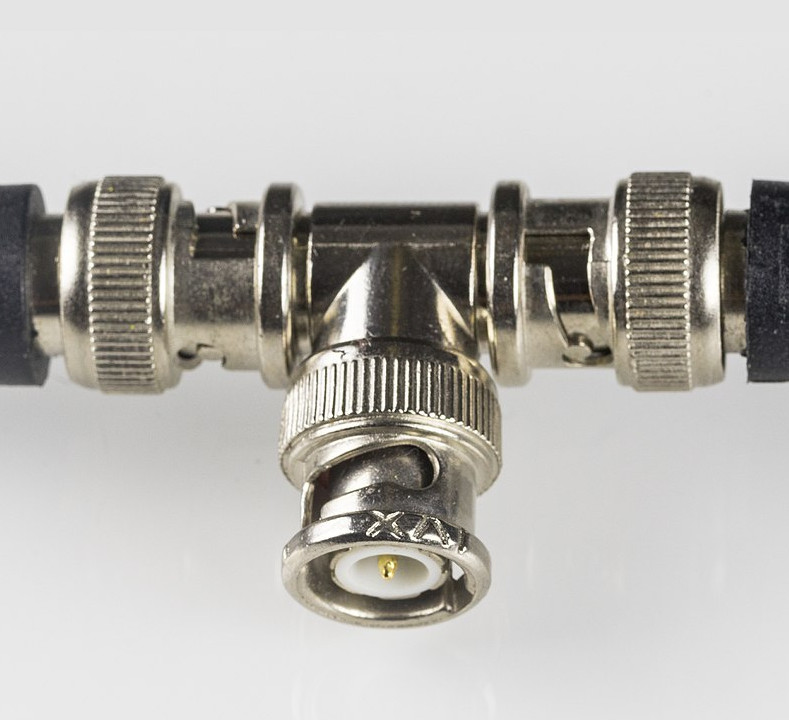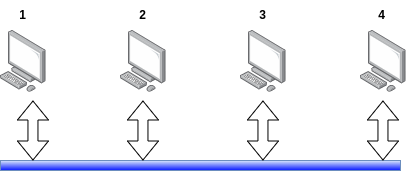The Bus Network Topology

In a bus network, all of the devices (terminals or computers) are connected to a single cable and send and receive information over that same one wire. Each device is issued with some kind of unique identity number (or address). A computer sends a message on the wire wrapped in an envelope that explains which device number the message is from and which device it is intended for.
A feature of a bus network is all the computers on the network receive all of the messages. They each read all of the envelopes and look out for their respective unique identity number. When they see it, they know the message is intended for them and process it. If the message is not intended for them, then they ignore it.

Broadband delivered via traditional cable television is often a bus network. A single cable was dug into the ground stretching the length of a street, often a long time ago before broadband was invented with no real intent that it would be used for this purpose. Each house tapped into the cable down along the length originally to receive the television signal. Subsequently, the same wire was re-used for delivering broadband and multiple houses share the same cable. Originally ethernet was a bus network although these days this type of ethernet is rarely used.
Collision Avoidance and Detection
Provided only one device wants to send information at once then all is well. However a problem is presented when multiple computers want to send information at the same time. If two computers decide to talk over the wire simultaneously, the information will become an incomprehensible mixture of the two messages. This is a collision. One way of solving this is called Carrier Sense Multiple Access - or CSMA. In this technique a computer intending to send information first listens on the wire to see that it is silent and no other computer is transmitting. If so then it sends a message, otherwise it waits until the wire is clear. Avoiding two computers talking at the same time on the cable is known as collision avoidance.
In a bus network, there will usually be a convention on the maximum length of time that a device may transmit for (often expressed as a maximum message size). This avoids any one device from hogging the cable. If a device has a lot to transmit, it will eventually yield and let some other device speak, then continue transmitting if no other device wants to use the cable.
Even though CSMA generally avoids two devices speaking at the same time, it is still possible for it to happen. Two devices might listen out at precisely the same time, see the wire is clear and start transmitting. To solve the problem, collision detection techniques are used. A device usually achieves this by listening on the wire whilst transmitting. It might verify that what it hears is precisely what was sent. If not, then some other machine may have interfered with the transmission by sending at the same time. Another method is measuring the overall amplitude (loudness) of the signal on the wire. This is like if multiple people start speaking in a room at once, the overall volume level in the room goes up versus just one person speaking.
When a collision is detected, all the transmitters stop sending. A problem arises though as to what to do now. If both the colliding transmitters immediately started sending again, the same problem would be repeated. This could go on forever with the wire never become clear. Both transmitters jam each other, stop and re-send, then end up jamming each other again and again. One way of solving this is with random back-off. In this approach when a pair of transmitters detect each is being jammed by the other, they both stop and choose a random period of time to wait before starting to send again. Whichever transmitter chooses the shortest waiting time speaks first and the other then senses that the wire is in use and waits until it is clear.
Collision detection and CSMA are not the only means of avoiding two devices talking at the same time on a bus network. Another alternative is polling. In this approach, one device is designated as the master controller and coordinates transmission by asking each other device on the wire in turn if it has something to say. The device may only speak when asked which avoids multiple devices talking at the same time.
Another approach is token passing. In this scheme, each device on the network passes permission to speak to the next. The permission is called the token. This system is sometimes used in meetings where there is conflict between multiple speakers all wanting to talk at once. Some handy object is designated as a token and each person in the meeting may only speak if they have the object. When a person has finished speaking, they pass the permission object to someone else. An advantage of token passing over polling is that no central master controller is required to coordinate who may speak.
In a CSMA network, each time there is a collision it costs time to resolve it. Firstly there is the wasted time from corrupted data that was sent before the collision happened, then there is more wasted time arbitrating who may speak next through the random delays. This is time when no useful data is being transmitted. An advantage of a token passing network is since there is never a collision there is less time wasted and more data can in theory be transmitted over the network in total. This improves network utilisation. Another advantage is token passing is deterministic. This means it is possible to calculate in advance what will happen in every situation on the network and how long any given network transmission is going to take. This is important in safety and time critical systems. In CSMA, the network may be jammed for some period of time that cannot be predicted in advance and who knows when the jam will clear and a message can get through.
A problem with token passing is that a device has to wait until such time as it gets the token before it may send its data. A device may think of something to say just after the token passed it and must wait for it to come round again. This increases latency, which is the time until data is transmitted.
TDMA (Time Division Multiple Access) is another way to mediate access to the cable. In this schema each device is allocated a specific time slot in which it may talk and must be silent when the time slot expires. This technique is sometimes used to moderate debates where multiple parties are allocated several minutes each to get their point across before they must yield to another party. TDMA is possible with modern electronics that are capable of precise time synchronisation. The time slots are handed out by a central controller. The amount of time each device gets to talk does not have to be even and the central controller may allocate a longer time slot to devices that seem to be regularly transmitting and shorter time slots to devices that seem to be usually silent. It may regularly change how much time is allocated to each device depending on how chatty it is. Similarly to token passing, TDMA has the advantage of improving utilisation of the cable by avoiding collisions entirely. However, it has the disadvantage of requiring a sophisticated central controller to allocate time slots such that use of the cable is maximised.
Next: The star network topology
Image credit: BNC connector
